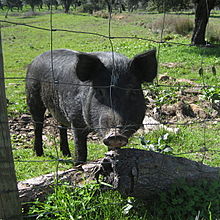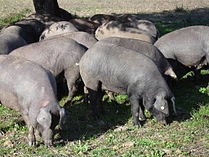219:
25:
363:
204:
144:
331:
This traditional breed exhibits a good appetite and propensity to obesity, including a great capacity to accumulate intramuscular and epidermal fat. The high intramuscular fat is what produces the typical marbling; this, together with traditional feeding based on acorns, is what makes its
297:. This cross gave rise to the ancestors of what are today Iberian pigs. The production of Iberian pig is deeply rooted to the Mediterranean ecosystem. It is a rare example in world swine production where the pig contributes so decisively to the preservation of the
328:. In the past few years, however, the production of pigs of the Iberian type has increased to satisfy a renewed demand for top-quality meat and cured products. At the same time, breed specialisation has led to the disappearance of some ancestral varieties.
65:, is a useful starting point for translations, but translators must revise errors as necessary and confirm that the translation is accurate, rather than simply copy-pasting machine-translated text into the English Knowledge.
336:
taste so special. Iberian pigs are interesting from a human biomedical perspective because they present high feed intake and propensity to obesity, compatible with high values of serum leptin.
301:. The Iberian breed is currently one of the few examples of a domesticated breed which has adapted to a pastoral setting where the land is particularly rich in natural resources, in this case
498:
Fernandez-Figares I et al 2007: Serum profile of metabolites and hormones in obese (Iberian) and lean (Landrace) growing gilts fed balanced or lysine deficient diets. Livest Sci, 110:73-81.
398:
is a richly diverse habitat with four different types of oak that are crucial in the production of prime-quality ham. The bulk of the acorn harvest comes from the holm oak (
75:
339:
The
Iberian pig can be either red or dark in colour, if black ranging from dark to grey, with little or no hair and a lean body, thus giving rise to the familiar name
353:
in
Portugal), they are constantly moving around and therefore burn more calories than confined pigs. This, in turn, produces the fine bones typical of this kind of
85:
Do not translate text that appears unreliable or low-quality. If possible, verify the text with references provided in the foreign-language article.
232:
511:
564:
531:
559:
70:
390:
is needed to raise a single pig, and since the trees may be several hundred years old, the prospects for reforesting lost
320:
The numbers of the
Iberian breed have been drastically reduced since 1960 due to several factors such as the outbreak of
93:
106:
Content in this edit is translated from the existing
Spanish Knowledge article at ]; see its history for attribution.
218:
484:
Analysis of genetic diversity and conservation priorities in
Iberian pigs based on microsatellite markers
285:
The most commonly accepted theory is that the pigs were first brought to the
Iberian Peninsula by the
101:
508:
466:
428:) season, which between them extend the acorn-production period from September almost to April.
404:) from November to February, but the season would be too short without the earlier harvests of
115:
483:
465:
Available online 18 October 2003; Departamento de
Producción Animal, Facultad de Veterinaria,
122:
528:
400:
343:, or "black hoof". In traditional management, animals ranged freely in sparse oak forest (
306:
8:
554:
321:
37:
486:
442:
355:
223:
263:
168:
97:
462:
535:
515:
310:
548:
271:
405:
255:
286:
228:
208:
325:
104:
to the source of your translation. A model attribution edit summary is
298:
294:
267:
266:. The Iberian pig, whose origins can probably be traced back to the
437:
421:
413:
375:
362:
314:
279:
245:
157:
153:
203:
149:
482:
E Fabuel, E; Barragán, C; Silió, L; Rodríguez, L C and Toro, M A
290:
62:
470:
345:
143:
379:
302:
275:
251:
212:
489:(2004) 93, 104–113, advance online publication 19 May 2004
231:"Bellota Oro", was selected as "best ham in the world" in
333:
184:
74:
to this template: there are already 957 articles in the
58:
289:from the Eastern Mediterranean coast (current-day
274:started, is currently found in herds clustered in
546:
374:in Portugal, is an Iberian (Spanish/Portuguese)
148:Black pig being raised in the countryside near
463:Sustained utilization of the Iberian pig breed
100:accompanying your translation by providing an
49:Click for important translation instructions.
36:expand this article with text translated from
142:
361:
217:
202:
547:
278:and the central and southern part of
18:
13:
565:Pig breeds originating in Portugal
14:
576:
243:, also known in Portugal as the
23:
560:Pig breeds originating in Spain
112:{{Translated|es|Cerdo ibérico}}
521:
501:
492:
476:
455:
386:At least a hectare of healthy
110:You may also add the template
1:
448:
293:), where they interbred with
7:
431:
82:will aid in categorization.
10:
581:
57:Machine translation, like
324:and the lowered value of
179:
174:
164:
141:
38:the corresponding article
394:are slim at best. True
262:) that is native to the
467:Universidad Complutense
382:-fed black Iberian pig.
372:Presunto de Porco Preto
121:For more guidance, see
529:The Wild West of Spain
383:
236:
215:
514:May 21, 2008, at the
365:
260:Sus scrofa domesticus
221:
206:
123:Knowledge:Translation
94:copyright attribution
412:) and Portuguese or
401:Quercus rotundifolia
235:2007, 2010 and 2013.
322:African swine fever
250:, is a traditional
138:
534:2008-03-22 at the
443:List of pig breeds
418:Quercus lusitanica
384:
237:
216:
136:
102:interlanguage link
410:Quercus pyrenaica
366:The ham known as
264:Iberian Peninsula
201:
200:
169:Iberian Peninsula
165:Country of origin
134:
133:
50:
46:
572:
539:
525:
519:
509:Free little pigs
505:
499:
496:
490:
480:
474:
461:Lopez-Bote, C J
459:
420:), and the late
207:Iberian pigs in
193:
187:
146:
139:
135:
113:
107:
81:
80:|topic=
78:, and specifying
63:Google Translate
48:
44:
27:
26:
19:
580:
579:
575:
574:
573:
571:
570:
569:
545:
544:
543:
542:
536:Wayback Machine
526:
522:
516:Wayback Machine
507:Eveleigh, Mark
506:
502:
497:
493:
481:
477:
460:
456:
451:
434:
197:
191:
183:
160:
130:
129:
128:
111:
105:
79:
51:
45:(November 2018)
28:
24:
17:
12:
11:
5:
578:
568:
567:
562:
557:
541:
540:
520:
500:
491:
475:
453:
452:
450:
447:
446:
445:
440:
433:
430:
378:made from the
270:, when animal
199:
198:
196:
195:
192:Sus domesticus
188:
180:
177:
176:
172:
171:
166:
162:
161:
147:
132:
131:
127:
126:
119:
108:
86:
83:
71:adding a topic
66:
55:
52:
33:
32:
31:
29:
22:
15:
9:
6:
4:
3:
2:
577:
566:
563:
561:
558:
556:
553:
552:
550:
537:
533:
530:
524:
518:December 2007
517:
513:
510:
504:
495:
488:
485:
479:
472:
468:
464:
458:
454:
444:
441:
439:
436:
435:
429:
427:
426:Quercus suber
423:
419:
415:
411:
407:
403:
402:
397:
393:
389:
381:
377:
373:
370:in Spain and
369:
368:Jamón Ibérico
364:
360:
358:
357:
356:jamón ibérico
352:
348:
347:
342:
337:
335:
329:
327:
323:
318:
316:
312:
308:
304:
300:
296:
292:
288:
283:
281:
277:
273:
272:domestication
269:
265:
261:
257:
253:
249:
247:
242:
234:
230:
226:
225:
224:Jamón Ibérico
220:
214:
210:
205:
194:
189:
186:
182:
181:
178:
173:
170:
167:
163:
159:
155:
151:
145:
140:
124:
120:
117:
109:
103:
99:
95:
91:
87:
84:
77:
76:main category
73:
72:
67:
64:
60:
56:
54:
53:
47:
41:
39:
34:You can help
30:
21:
20:
538:October 2005
527:Harris, Don
523:
503:
494:
478:
457:
425:
417:
409:
406:Pyrenean oak
399:
395:
391:
387:
385:
371:
367:
354:
350:
344:
340:
338:
330:
319:
284:
259:
256:domestic pig
244:
240:
238:
233:IFFA Delicat
222:
190:
98:edit summary
89:
69:
43:
35:
16:Breed of pig
326:animal fats
287:Phoenicians
241:Iberian pig
209:Extremadura
137:Iberian pig
555:Pig breeds
549:Categories
449:References
349:in Spain,
341:pata negra
295:wild boars
40:in Spanish
305:from the
299:ecosystem
268:Neolithic
116:talk page
68:Consider
532:Archived
512:Archived
487:Heredity
438:Presunto
432:See also
422:cork oak
414:gall oak
376:delicacy
315:cork oak
311:gall oak
307:holm oak
280:Portugal
246:Alentejo
158:Portugal
154:Alentejo
92:provide
473:, Spain
351:montado
291:Lebanon
254:of the
114:to the
96:in the
42:.
471:Madrid
396:dehesa
392:dehesa
388:dehesa
346:dehesa
303:acorns
175:Traits
380:acorn
276:Spain
252:breed
229:BEHER
213:Spain
150:Évora
59:DeepL
313:and
239:The
90:must
88:You
359:.
334:ham
248:Pig
185:Pig
61:or
551::
469:,
317:.
309:,
282:.
227:,
211:,
156:,
152:,
424:(
416:(
408:(
258:(
125:.
118:.
Text is available under the Creative Commons Attribution-ShareAlike License. Additional terms may apply.


